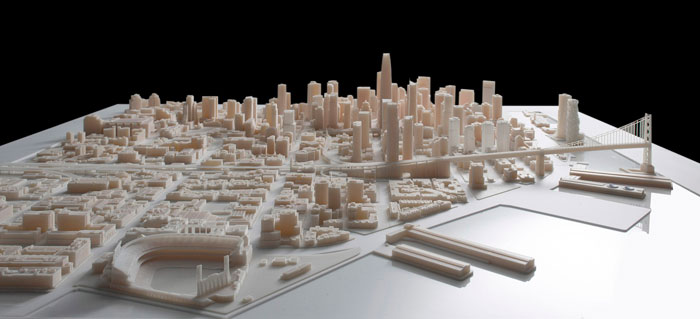Autodesk and creative agency Steelblue have demonstrated just how small the world can be with the largest 3D printed scale model of San Francisco to date. The model, fabricated on two Objet Connex500 3D printers at Autodesk’s Pier 9 workshop, replicates more than 115 blocks of the City by the Bay, covering the Financial and the South of Market districts.
The task of recreating the city in 3D printed form was commissioned by real-estate developer, Tishman Speyer, which needed a visual aid to tell the story of urban development in SF’s South of Market (SoMa) neighborhood, a large section of the city that includes lots of warehouses, shops, lofts and condos and is home to some big names in tech, like Twitter, Foursquare, Dropbox, Wired, Yelp, Zynga, and BitTorrent Inc. Digitally designed by Steelblue, using photogrammetry, city planning data and architectural drawings, the scale-model includes such landmarks as AT&T Park, the Ferry Building and the San Francisco Museum of Modern Art. While the digital recreation has been years in the making, the 3D printed version took about two months to complete and was the largest job Pier 9 has yet taken on.
Such a model may give insight into urban planning and development projects already being undertaken by the city, including the Transbay Transit Center. The replica, printed with a resolution of 16 microns, features some buildings presently being built in their ultimate, completed form, showing off what portions of the city may look like in 2017. During the unveiling, the usefulness of the 3D printed model was demonstrated through the projection of infrastructure and traffic simulations over the model city’s Transbay District.

Due to the success of their model, the firm is in the process of fabricating other cities, as well. Autodesk senior product manager, Justin Lokitz, says, “We’ve been creating digital 3D models of cities around the world. They are incredible tools for urban planning, but sometimes the tactile experience of a physical model provides insights and understanding you can’t get from a screen. This project is really the embodiment of our Pier 9 Workshop – experimenting with new fabrication methods to bring the digital and physical worlds closer together.”
Though the original model will stay with Tishman Speyer, Autodesk will be displaying a second copy at its own gallery, where members of the public will be able to see it for themselves.
Source: Autodesk




